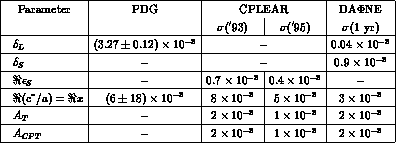 can be measured at
DA
can be measured at
DA NE by selecting the following final states
NE by selecting the following final states
 , where
, where
 ,
,  and
and  is one
of the allowed final states in
is one
of the allowed final states in  decays
(
decays
( or
or  ).
The probability of such events is obtained by
integrating eq. (5)
).
The probability of such events is obtained by
integrating eq. (5) initial
initial  pairs is given by:
pairs is given by:
The semileptonic branching ratios of the  can be measured at
DA
can be measured at
DA NE by selecting the following final states
NE by selecting the following final states
 , where
, where
 ,
,  and
and  is one
of the allowed final states in
is one
of the allowed final states in  decays
(
decays
( or
or  ).
The probability of such events is obtained by
integrating eq. (5)
).
The probability of such events is obtained by
integrating eq. (5)![]() in the appropriate time intervals
in the appropriate time intervals![]() .
Therefore the number of events for
.
Therefore the number of events for
 initial
initial  pairs is given by:
pairs is given by:
where
As can be seen,  is by far the dominant contribution; the branching
ratio products in eq. (25)
are predicted to be of the same order, while the interference
term should be further suppressed by large cancellations.
Therefore inserting the experimental value [24]
is by far the dominant contribution; the branching
ratio products in eq. (25)
are predicted to be of the same order, while the interference
term should be further suppressed by large cancellations.
Therefore inserting the experimental value [24]
 eq. (25) becomes:
eq. (25) becomes:
The project luminosity of DA NE (
NE ( )
gives about
)
gives about  /year.
Using eq. (22) and the present upper limit on the
violation of the
/year.
Using eq. (22) and the present upper limit on the
violation of the  rule [24], we estimate
rule [24], we estimate
 and
and  ,
therefore
,
therefore  events/year are expected.
events/year are expected.
With these numbers we can estimate the sensitivity of DA NE to CP, CPT
and the
NE to CP, CPT
and the  rule violating parameters defined in
eqs. (23) and (24).
Since the
rule violating parameters defined in
eqs. (23) and (24).
Since the  final state
can hardly be distinguished
from the
final state
can hardly be distinguished
from the  one, we conservatively assume that
only electrons can be used to derive
one, we conservatively assume that
only electrons can be used to derive  charge asymmetry.
In this case the number of event is
charge asymmetry.
In this case the number of event is  /year
and the statistical error
on
/year
and the statistical error
on  turns out to be
turns out to be  .
Since the experimental value of
.
Since the experimental value of  charge asymmetry is
charge asymmetry is
 [24], we expect
[24], we expect  ,
testing the CPT prediction
,
testing the CPT prediction  at a significant level.
at a significant level.
Eq. (24) (test of  rule) involves
the semileptonic rates of
rule) involves
the semileptonic rates of  and
and  ;
thus to estimate the error on
;
thus to estimate the error on  one has to take into account also the experimental errors on tagging
branching ratios and on
one has to take into account also the experimental errors on tagging
branching ratios and on  widths. Using the values in
Ref. [24], these effects give a large contribution to the total error,
which turns out to be
widths. Using the values in
Ref. [24], these effects give a large contribution to the total error,
which turns out to be  , whereas
the pure statistical contribution would give only
, whereas
the pure statistical contribution would give only  .
This large value for
.
This large value for  will perhaps be lowered by
measuring all the quantities involved in the same experimental set-up.
will perhaps be lowered by
measuring all the quantities involved in the same experimental set-up.

Table 1: Comparison between the present experimental data
[24],
CPLEAR present and expected sensitivity
[25] and the
achievable sensitivity in 1 year at DA NE, for the semileptonic
parameters. For both CPLEAR and DA
NE, for the semileptonic
parameters. For both CPLEAR and DA NE only the statistical
error has been reported. Note that
NE only the statistical
error has been reported. Note that  and
and  asymmetries
have different theoretical expressions, for
CPLEAR and DA
asymmetries
have different theoretical expressions, for
CPLEAR and DA NE, if one considers CPT
violation in the decay amplitudes.
NE, if one considers CPT
violation in the decay amplitudes.
In Table 1 we report the predicted sensitivity of DA NE in
comparison with other experiments.
As one can see, DA
NE in
comparison with other experiments.
As one can see, DA NE
is very powerful to test
NE
is very powerful to test  rule.
rule.